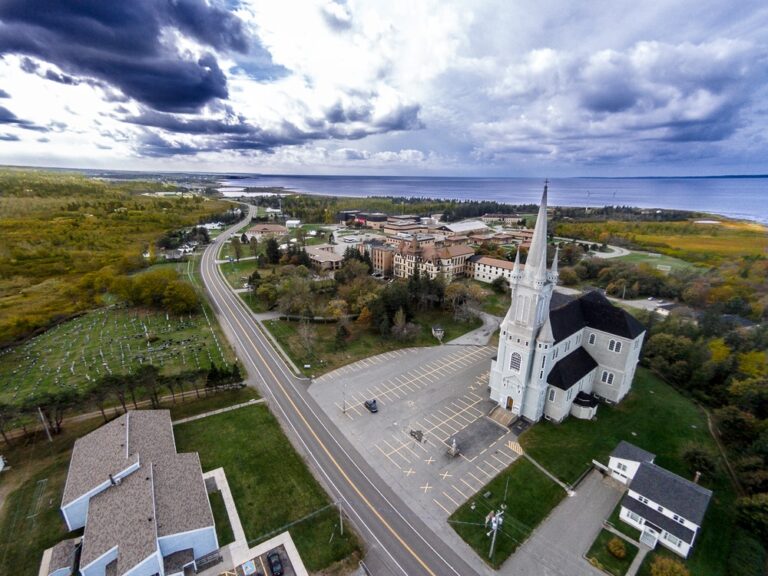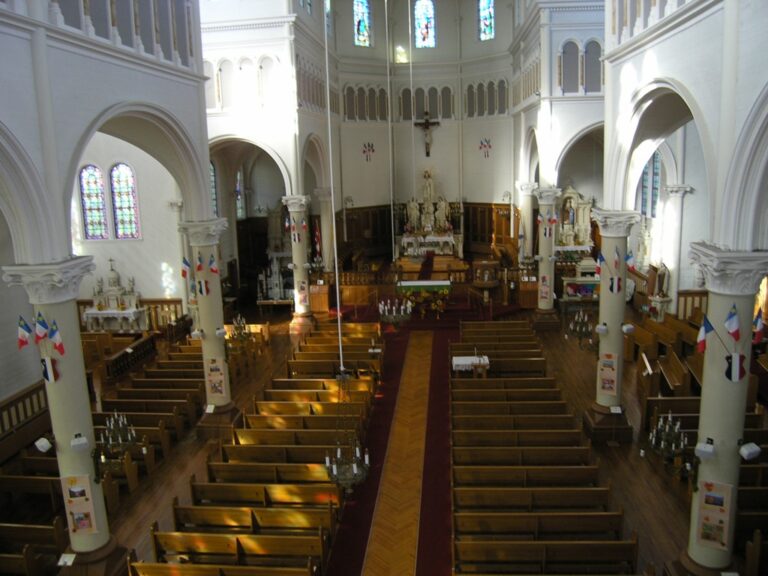From Awareness to Action: Designing an Innovative Approach to Saving a Beloved Acadian Landmark
“We’re trying to save a landmark. We’re trying to save a heritage building that has national and international interest,”
says Stéphanie St. Pierre as she reflects on the preservation campaign that she and Gabrielle Bardall launched in December 2024 to save the Église Sainte-Marie from its planned demolition.

Église Ste Marie, Church Point, Nova Scotia. Photo by: Tourism Nova Scotia
Located in Church Point, Nova Scotia, the Église Sainte-Marie is considered North America’s tallest wooden church. Built between 1903-1905 by 1,500 Acadian volunteers, it was constructed after the return of the community to Nova Scotia following the Expulsion in 1755. To many in the community, the Église Sainte-Marie is still a towering symbol of Acadian resilience and ingenuity as well as a beloved monument to their local heritage.
In November 2024, following a series of community-driven attempts to restore the church – which had been closed in 2019 due to safety concerns – the Archdiocese of Halifax-Yarmouth put out an RFP for the complete demolition of the heritage building. This was to be completed in Spring 2025.
When Stéphanie and Gabrielle heard about the plan to demolish the Église Sainte-Marie, they knew they had to act quickly. While previous efforts to repair the church had focused on fundraising, there was no clear strategy to secure provincial or federal support or heritage recognition. Their goal was to develop a new approach which aimed to do exactly that.

Église Ste Marie, Church Point, Nova Scotia. Photo by: Tourism Nova Scotia
Within two weeks of the announcement, Stéphanie and Gabrielle had established a team of volunteers and began attracting support from national and international heritage organizations. In January 2025, they incorporated the Association Sainte-Marie Héritage et Développement to support their new and sustainable approach to preserving the prized Acadian landmark.
Focusing on transparency, community involvement, and drawing on their complementary skill sets, they welcomed those with diverse backgrounds to their new organization. “A lot of community members were very interested in preserving and saving this building, but did not really know how,” says Gabrielle. “By coming together and everyone sharing a little bit of their experience and expertise it’s been made possible.”
Stéphanie and Gabrielle’s are both professors at the Université Sainte-Anne, the only French-language university in Nova Scotia with strong ties to the Acadian community. In addition to their passion for heritage preservation, their academic backgrounds have also proved invaluable to the project.
Stéphanie holds a Doctorate in History from Université de Montréal (2020), along with a Master of Arts (2006) and Bachelor of Arts (2004) from Laurentian University in Sudbury, Ontario. Her research focuses on intellectual history and the construction of identity in minority communities – especially Francophone minorities – exploring how historical narratives shape feelings of belonging. Originally from a small Francophone community in Northern Ontario, her research has personal resonance.
Gabrielle earned her Doctorate in Political Science from Université de Montréal (2016), a Master of Arts from Sciences Po Paris (2004), and a Bachelor of Arts from McGill University (2002). Her background is in international organizations and political development in war-torn countries. Born in the United States, Garbrielle moved to Nova Scotia in 2020 to begin her position at the Université Sainte-Anne. Reflecting on what drew her to the project, she says, “Sainte-Marie was such an extraordinary place. I’ve been to 65 countries; I’ve seen a lot of cool places. Sainte-Marie really stood out for being exceptional — and for its very poor condition.”
Stéphanie and Gabrielle explain that their focus has been on raising awareness of Sainte-Marie’s heritage status in the hopes of securing future support at the provincial, federal, and international levels. Their efforts have already had an impact with ICOMOS issuing a Heritage Alert on May 15th: “We’ve been working to contact key political officials in the coming days and weeks to follow up on ICOMOS recommendations,” says Stephanie — efforts made possible by Gabrielle’s expertise.

Église Ste Marie Interior. Photo by André Valotaire.
The rate at which their efforts have created an impact since the beginning of 2025 is impressive. When they launched the Association Sainte-Marie Héritage et Développement in January 2025, they began with weekly meetings at Stéphanie’s house. On June 1st they will be hosting their first large-scale public meeting to share their plans for the adaptive reuse of the church and update the community on where the project currently stands. Social media has also been a key tool for keeping the community informed throughout the process.
Reflecting on their personal commitments to the project, Stéphanie notes the amount of time that both she and Gabrielle have dedicated as well as why they feel it is important that they take on this work: “Gabrielle and I are both mothers. We’re both professionals. We’re both at points in our careers where there are a lot of demands. We’ve taken this on because we truly believe in it. It’s a labor of love. And I think a lot of people are deeply passionate about heritage buildings. I know we both are. […] I can’t imagine Sainte-Marie not being there. It just doesn’t make sense. And for my children who grew up here, it’s the same thing. And you speak to younger people, and they say it’s our skyline; it’s our landmark.”


On the left: Gabrielle Bardall (Photo Credit: Kate Haake). On the right: Stephanie St. Pierre (Photo Credit: Vanessa Wilson).

